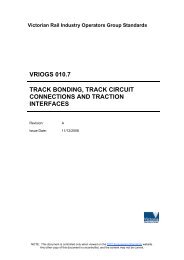VRIOGS 002.1 Railway Station Design Standard and Guidelines
VRIOGS 002.1 Railway Station Design Standard and Guidelines
VRIOGS 002.1 Railway Station Design Standard and Guidelines
Create successful ePaper yourself
Turn your PDF publications into a flip-book with our unique Google optimized e-Paper software.
<strong>VRIOGS</strong> <strong>002.1</strong> Revision A 11The statutory requirements for Emergency Services as outlined in the Building Code ofAustralia does not provide for a live rail environment <strong>and</strong> the rail operational <strong>and</strong> accessissues which are unique to railway stations. Due to this, additional infrastructure isrequired for fire fighting, emergency access <strong>and</strong> portable extinguishers with the designinput for these elements to be provided by the Accredited Rail Operator (ARO) as part ofthe normal design approval process.4.4 SECURITYThe purpose of security design is to protect passengers, staff <strong>and</strong> rail infrastructure assetsfrom crime. Basic security requirements <strong>and</strong> site-specific issues vary from station tostation depending on the station category <strong>and</strong> the surrounding locale.Security can be achieved by the provision of:a) Natural surveillance. Including the location of key station facilities such that activesurveillance of the passenger’s facilities <strong>and</strong> vertical elements are maximised.Provision where possible should also be made to allow for uninterrupted viewsfrom the station building to the platforms;b) Access control. Including providing fencing <strong>and</strong> gate control;c) Target Hardening. Strengthening the security of the station in order to reduce orminimise the risk of attack or theft. It is directed at denying or limiting access to acrime target through the use of physical barriers such as fences, gates, locks,electronic alarms <strong>and</strong> security patrols;d) Systems. Including remote surveillance via closed circuit television (CCTV) <strong>and</strong>provision of designated passenger Safety Zones with associated PassengerInformation Devices linked to the security system.4.5 ACCESSIBILITYAccessible public transport refers to the provision of access to public transport for allmembers of the community, including people with special needs.Requirements include:a) Enabling commuters to easily change to other modes of transport that are situatedin close proximity to the station, for example bicycle parking/storage, car parks <strong>and</strong>bus/coach/tram stops.b) <strong>Design</strong>ing <strong>and</strong> locating the station entry <strong>and</strong> station infrastructure, as identified byits category <strong>and</strong> the ARO’s requirements, to allow for physical access for allpassengers (current <strong>and</strong> future).c) Ensuring that the rail passenger’s needs are taken into account, for examplepassenger facilities identified by the station category <strong>and</strong> the rail operator’srequirements are provided.d) The station should be designed so that its layout is able to be comprehended byunfamiliar users <strong>and</strong> orientation only supplemented by signage <strong>and</strong> maps.e) New station designs <strong>and</strong>/or substantial alterations comply with the DDA <strong>and</strong> theDSAPT.NOTE: This document is controlled only when viewed on the DOT Engineering <strong>St<strong>and</strong>ard</strong>s website. Any othercopy of this document is uncontrolled, <strong>and</strong> the content may be inaccurate.

















